Bulky Equipment
-
- Fisheries Technology for Resource Management Marine Technology, May 2014 #36
The U.K. alone has 6,400 fishing vessels, with total landings of fish catch equating to $1.3 billion (627,000 tons) in 2012 (1). Despite warnings of a slowdown in the marine catch in the 1970s and 80s, the fishing industry increased fishing efforts with more powerful boats as well as superior technology, allowing the tracking of fish populations with sonar devices and larger nets to increase catch size. In addition, the international commercial fishing industry is double the size necessary to meet current requirements, and overcapacity is now a global norm. The European Union itself is in 40% overcapacity, resulting in fierce competition and difficulties in mitigating impacts with higher percentages found around the globe (2).
The Problem
Although overexploitation of fishing resources is the main issue, wasteful practices which resort in by-catch or discard is an area necessitating much focus by resource management schemes. By-catch has long been recognized as a widespread issue, with around 25% of total catch being discarded back into the sea dead due to little or no commercial value (3). This equates to approximately 27 million tons, the equivalent of 600 fully-laden Titanics (4).
The impact of by-catch to the ocean ecosystems is not only colossal but often irreversible (5). The different types of commercial fishing practices result in variations of species and quantities being killed as by-catch: nets kill cetaceans, long-line fishing kills birds and bottom trawling devastates marine ecosystems (5).
oShrimp fisheries are renowned to be inefficient and ecologically damaging, with often more than 80% of a catch comprising marine species other than shrimp which gets discarded (5). Bottom-trawling and beam-trawling, removes up to 20% of the seafloor fauna and flora in a single trawl, in addition to by-catch of commercially unattractive animals (5).
By-catch occurs due to fishing gears inability to adequately select target species, the problem worsened by economic pressures resulting from overexploitation (3). A large majority of by-catch is discarded due to fishing quotas minimizing landings (size of catch) and when regulatory restrictions prohibit retention of particular attributes (size, species, sex) (3, 5). Therefore, some by-catch occurs in commercial fisheries, however, higher rates are found in fisheries with less selective fishing methods and practices. Mitigating the environmental impact of commercial fishing by avoiding, minimizing and compensating for adverse effects, is fundamental for fisheries management authorities worldwide (6). The complex interplay of ecological, economic, and social considerations has often resulted in by-catch management being reactive, confrontational and costly (6). Some by-catch species, including fish, reptiles, birds and mammals, may be threatened with extinction (3). Even Tuna fisheries, which in the past had high dolphin by-catch levels, are still responsible for the deaths of an estimated one million sharks annually (5). Around the U.K., evidence of the growing scale of by-catch is washed up on beaches around the south west of England and northern France annually in the form of dolphin and porpoise corpses.
Progresses in technology for impact reduction has not been as quickly established as technologies designed to increase overall catch. Although modifications to fishing gear or practices have offered an effective means of reducing by-catch, such as turtle exclusion devices and Pingers, these devices need continual monitoring and in many cases it has been difficult to demonstrate success (3, 6). Therefore effective use of these devices depends on overcoming gear handling constraints and the short-term economic losses often associated with their use (3).
The Solution
The Icelandic high technology company Star-Oddi has developed revolutionary equipment that filters out the majority of unwanted by-catch, (up to 75% of the by-catch). The Fish Selector, which is an equipment that automatically separates the fish while still in the trawl, means that discarding of fish by fishing companies could be a thing of the past.
The aims of using Fish Selector are to increase the value of the catch, avoid discard of fish and increase fishing efficiency by helping with decision making for the skipper of selecting a fishing area. In addition to benefitting the commercial fisheries companies the marine research institutes may find scientific value in using the equipment in their studies.
The Fish Selector is placed in front of the cod-end and as the fish swim through the device it is pre-programmed to select fish by specific size and species so those that are not intended for landing, are sorted out and directed away through a bypass gate. Collected information is wirelessly monitored in real-time in the bridge on the quantity of fish caught, as well as quantity bypassed. Other data can be collected such as depth, temperature and inclination.
Data on how many fish are caught and how many are released is automatically stored and sent in real time onboard the vessel. Collected information on quantity of caught fish and bypassed fish can be viewed wirelessly by the crew. The data gives insight into the quality of the fishing ground so the skipper can quickly and better estimate if fishing should continue or if movement to a different area would be beneficial. The emphasis on responsible and sustainable fisheries has been increasing. Fishing companies using the Fish Selector can help in delivering the message to consumers that the company is making its contribution to sustainable fisheries by releasing threatened species.
Field Testing
In December 2010 the Fish Selector was tested on the research ship Drofn. It operated very well on its first sea trial. Since then, focus has been on reducing the size of the equipment which will give the fishermen the following advantages:
Takes less deck space
Smaller volume and weight decreases hazards associated with having bulky equipment on deck
Fishermen can more easily move the equipment around and the smaller device is then carried by two operatives
Smaller volume and lower weight will make it easier to take the device onto smaller ships, increasing the market potential
First Prize Innovation Award for the Fish Selector
Star-Oddi won first prize for the most innovative technology for the fishing industry at the Icelandic Fisheries Conference. The conference was held for the fourth time in November 2013. People from fishing companies, state officials and scientists attend this conference. The goal of the award is to encourage creative thinking and innovation in the fisheries sector.
About Star-Oddi
Star-Oddi (Iceland) develops research equipment for increasing the knowledge on marine life and underwater environments. Star-Oddi specializes in the design and manufacture of scientific equipment, mainly miniature data loggers containing microelectronics and sensors for monitoring behavioral and environmental parameters such as salinity, temperature, depth, tilt angle and more. The miniature self-contained loggers are used for behavioural studies of fish as well as on moorings and nets.
References
(1) Overview of the UK fishing Industry (2013). Retrieved from Marine Management Organization website: www.marinemanagement.org.uk/fisheries/statistics/annual.htm
(2) World Fisheries: Declines, Potential and Human Reliance (April, 2006). Retrieved from the University of Michigan website: www.globalchange.umich.edu/globalchange2/current/lectures/fisheries/fisheries.html
(3) Cook, R. (2003). The Magnitude and Impact of By-catch Mortality by Fishing Gear. In M. Sinclair & G. Valdimarsson (Eds.), FAO. Responsible Fisheries in the Marine Ecosystem.
(4) Threat 1: Overfishing (n.d.). Retrieved from Save Our Seas Foundation website: saveourseas.com/threats/overfishing
(5) Bycatch – wasteful and destructive fishing (n.d.). Retrieved from Greenpeace website: www.greenpeace.org.uk/oceans/problems/bycatch-wasteful-and-destructive-fishing
(6) Kirby, S.K., Ward, P. (2014). Standards for the effective management of fisheries bycatch. Marine Policy, 44, 419-426
(As published in the May 2014 edition of Marine Technology Reporter - http://www.marinetechnologynews.com/Magazine)
-
- Five Minutes with Paul Switzer Maritime Reporter, Aug 2016 #106
deadlines and budgets. Installers are mobile, which allows them to easily install fittings using a battery tool and move from deck-to-deck without bulky equipment. When considering the Viega advantage, press technology is only part of the picture. We maintain five strategically located manufacturing and
-
 )
March 2024 - Marine Technology Reporter page: 45
)
March 2024 - Marine Technology Reporter page: 45ronments. The new agreement will address speci? c techni- cal gaps in the UUV defense and offshore energy markets especially for long duration, multi-payload mission opera- tions where communications are often denied or restricted. As part of the new alliance, Metron’s Resilient Mission Autonomy portfolio
-
 )
March 2024 - Marine Technology Reporter page: 42
)
March 2024 - Marine Technology Reporter page: 42NEW TECH OCEANOLOGY INTERNATIONAL 2024 Image courtesy Greg Trauthwein Image courtesy BIRNS MacArtney launches the new ultra-compact ø12.7 mm SubConn Nano connector. Innovative connectivity built on 45 years of ? eld-proven and market-trusted design. Image courtesy MacArtney Birns celebrated its 70th
-
 )
March 2024 - Marine Technology Reporter page: 25
)
March 2024 - Marine Technology Reporter page: 25Auerbach explained that ideally, “one ? ed layers of geothermal activity,” noted changes over an area of 8,000 km2. They would have both instruments: seismom- Skett, “and the change in salinity and dis- found up to seven km3 of displaced ma- eters to detect and locate subsurface ac- solved particles for
-
 )
April 2024 - Maritime Reporter and Engineering News page: 47
)
April 2024 - Maritime Reporter and Engineering News page: 47MARKETPLACE Products & Services www.MaritimeEquipment.com Powering the fleet for 60 years! HYDRAULIC NOISE, SHOCK AND VIBRATION SUPPRESSOR Noise, Shock, VibraO on & PulsaO on in Quiet, Smooth Flow Out Oil Bladder Nitrogen (blue) Manufactured by MER
-
 )
April 2024 - Maritime Reporter and Engineering News page: 43
)
April 2024 - Maritime Reporter and Engineering News page: 43“The industry is an ecosystem which includes owners, managers, mariners, shipyards, equipment makers, designers, research institutes and class societies: all of them are crucial,” – Eero Lehtovaara, Head of Regulatory & Public Affairs, ABB Marine & Ports All images courtesy ABB Marine and Ports provi
-
 )
April 2024 - Maritime Reporter and Engineering News page: 42
)
April 2024 - Maritime Reporter and Engineering News page: 42OPINION: The Final Word Seeing the Ship as a System Shipping must engage with the decarbonization realities that lie ahead by changing the way it crafts maritime legislation to re? ect its place in the interconnected, interdependent world economy, said Eero Lehtovaara, ABB Marine & Ports. ABB Marine &
-
 )
April 2024 - Maritime Reporter and Engineering News page: 35
)
April 2024 - Maritime Reporter and Engineering News page: 35SIMULATION e have a close relationship with tech- Realism is prized beyond immersive, photo-realistic visu- nology, evidenced by, for example, als, and providers are introducing increasingly accurate func- the phones we are estimated to un- tionality. FORCE Technology’s upcoming DEN-Mark2 math- lock around
-
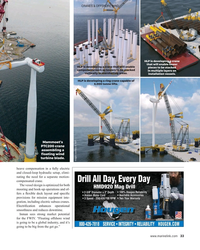 )
April 2024 - Maritime Reporter and Engineering News page: 33
)
April 2024 - Maritime Reporter and Engineering News page: 33CRANES & OFFSHORE WIND HLP is developing a crane that will enable tower HLP is developing a crane that will enable pieces to be stacked components such as towers to be stacked in multiple layers on vertically in marshalling areas. installation vessels. HLP is developing a ring crane capable of 6
-
 )
April 2024 - Maritime Reporter and Engineering News page: 25
)
April 2024 - Maritime Reporter and Engineering News page: 25RADM PHILIP SOBECK, MILITARY SEALIFT COMMAND Photo by Brian Suriani USN Military Sealift Command From a global supply chain perspective, What makes MSC so vital to the we’ve learned a lot about dealing with Navy’s ? eet and our military disruptions. COVID delivered a big forces around the world? wake-up
-
 )
April 2024 - Maritime Reporter and Engineering News page: 16
)
April 2024 - Maritime Reporter and Engineering News page: 16MARKETS SOVs – Analyzing Current, Future Demand Drivers By Philip Lewis, Director of Research, Intelatus © Björn Wylezich/AdobeStock t a high-level, there are three solutions to transferring Lower day rate CTVs are often used for daily transfer of technicians from shore bases to offshore wind farms
-
 )
April 2024 - Maritime Reporter and Engineering News page: 15
)
April 2024 - Maritime Reporter and Engineering News page: 15hydro-acoustic design of a propulsor that delays cavitation meets its underwater noise limits. This will require specialized inception and cavitating area. The third approach should be test sites or specialized mobile underwater testing equipment. isolation mounting of a vibro-active equipment and
-
 )
April 2024 - Maritime Reporter and Engineering News page: 14
)
April 2024 - Maritime Reporter and Engineering News page: 14Book Review Approach to Meeting Underwater Radiated Noise Limits Def ned By Raymond Fischer uantitative underwater radiated noise limits will construction inspections, 5) possible training with respect to be developed shortly by IMO, and/or countries salient design/construction essentials, 6) compliance
-
 )
April 2024 - Maritime Reporter and Engineering News page: 13
)
April 2024 - Maritime Reporter and Engineering News page: 13from gasoline to methanol, but compared to just buying an EV After some pondering, I think I can reduce it to this logi- today that is a pointless exercise. It would actually make more cal sequence: sense to buy a plug-in hybrid that is con? gured for methanol It is the carbon. We want zero carbon as
-
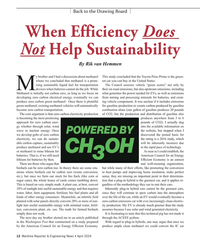 )
April 2024 - Maritime Reporter and Engineering News page: 12
)
April 2024 - Maritime Reporter and Engineering News page: 12Back to the Drawing Board When Efficiency Does Not Help Sustainability By Rik van Hemmen y brother and I had a discussion about methanol This study concluded that the Toyota Prius Prime is the green- where we concluded that methanol is a prom- est car you can buy in the United States. ising sustainable
-
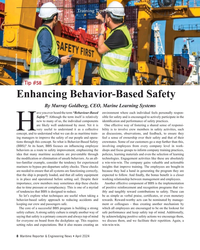 )
April 2024 - Maritime Reporter and Engineering News page: 8
)
April 2024 - Maritime Reporter and Engineering News page: 8Training Tips for Ships © By tuastockphoto/AdobeStock Tip #58 Enhancing Behavior-Based Safety By Murray Goldberg, CEO, Marine Learning Systems ave you ever heard the term “Behaviour-Based environment where each individual feels personally respon- Safety”? Although the term itself is relatively sible for
-
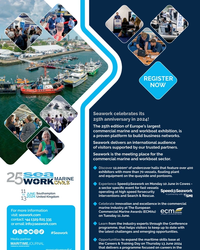 )
April 2024 - Maritime Reporter and Engineering News page: 7
)
April 2024 - Maritime Reporter and Engineering News page: 7REGISTER NOW Seawork celebrates its 25th anniversary in 2024! The 25th edition of Europe’s largest commercial marine and workboat exhibition, is a proven platform to build business networks. Seawork delivers an international audience of visitors supported by our trusted partners. Seawork is the
-
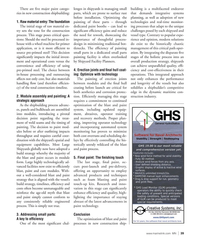 )
April 2024 - Marine News page: 39
)
April 2024 - Marine News page: 39There are ? ve major paint catego- lenges in shipyards is managing small building is a multifaceted endeavor ries in new construction shipbuilding: parts, which are prone to surface rust that demands integrative systems before installation. Optimizing the planning, as well as adoption of new 1.
-
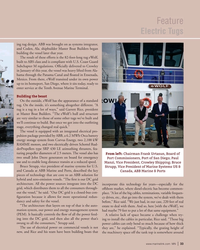 )
April 2024 - Marine News page: 33
)
April 2024 - Marine News page: 33Feature Electric Tugs ing tug design. ABB was brought on as systems integrator, and Coden, Ala. shipbuilder Master Boat Builders began building the vessel later that year. The result of these efforts is the 82-foot-long tug eWolf, built to ABS class and is compliant with U.S. Coast Guard Subchapter M
-
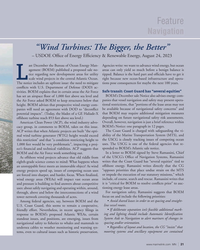 )
April 2024 - Marine News page: 21
)
April 2024 - Marine News page: 21Feature Navigation “Wind Turbines: The Bigger, the Better” – USDOE Of? ce of Energy Ef? ciency & Renewable Energy, August 24, 2023 ast December the Bureau of Ocean Energy Man- Agencies write: we want to advance wind energy, but ocean agement (BOEM) published a proposed sale no- areas can only yield so
-
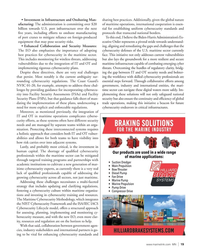 )
April 2024 - Marine News page: 19
)
April 2024 - Marine News page: 19• Investment in Infrastructure and Onshoring Man- sharing best practices. Additionally, given the global nature ufacturing: The administration is committing over $20 of maritime operations, international cooperation is essen- billion towards U.S. port infrastructure over the next tial for establishing
-
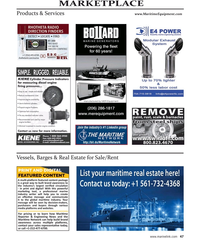 )
February 2024 - Maritime Reporter and Engineering News page: 47
)
February 2024 - Maritime Reporter and Engineering News page: 47MARKETPLACE Products & Services www.MaritimeEquipment.com Powering the fleet for 60 years! Manufactured by MER Equipment (206) 286-1817 www.merequipment.com Join the industry’s #1 Linkedin group http://bit.do/MaritimeNetwork Vessels, Barges & Real Estate
-
 )
February 2024 - Maritime Reporter and Engineering News page: 44
)
February 2024 - Maritime Reporter and Engineering News page: 44Tech Files Latest Products & Technologies MarineShaft Yanmar Hydrogen MarineShaft specializes in urgent re- Fuel Cell AIP pair/replacement of damaged rudder and Yanmar Power Technology Co., Ltd. propeller equipment along with many (Yanmar PT), a subsidiary of Yanmar on-site repair services. MarineShaft
-
 )
February 2024 - Maritime Reporter and Engineering News page: 36
)
February 2024 - Maritime Reporter and Engineering News page: 36HYBRID 2-stroke controllable pitch propeller PTO powertrain Source: MAN Energy Solutions how the system is intended to operate, says Oskar Levander, VP Strategy & Business Development, Kongsberg Maritime. For example, a primary shaft-driven PTO rotates whenever the engine is running; a secondary one
-
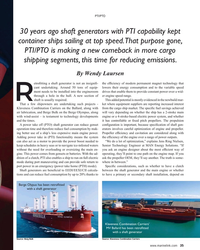 )
February 2024 - Maritime Reporter and Engineering News page: 35
)
February 2024 - Maritime Reporter and Engineering News page: 35PTI/PTO 30 years ago shaft generators with PTI capability kept container ships sailing at top speed. That purpose gone, PTI/PTO is making a new comeback in more cargo shipping segments, this time for reducing emissions. By Wendy Laursen etro? tting a shaft generator is not an insigni? - the ef? ciency
